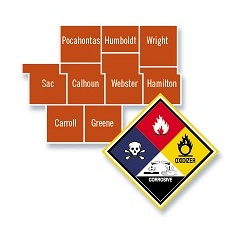Facts about Region V Hazardous Materials Response Team.
How did the hazardous materials agreement come to exist in Region V?
The Region V Hazardous Materials Response Team did not exist prior to 1994. The local counties in Region V relied on the local fire departments and industries in the area to provide response for the public's safety. Because of extensive training requirements and high costs associated with starting and maintaining a ready response group, the local departments or industries could not afford to meet this challenge alone. The Region V hazardous Materials Response Commission and Local Emergency Planning Committee was formed. This unique organization, through its membership, formed a vision and used proactive actions to enter into an agreement with the Fort Dodge Fire Department to allow Hazardous Materials Response to all citizens in the region. The region has an excellent record of safe and successful responses dealing with hazardous materials. This will only continue through the agreement. The agreement has built strong working relationships and cooperation while providing a much-needed service in the interest of the public.
Who Pays for this service?
Nine counties represent Region V. Each County contributes one dollar and fifty cents per capita each year for membership. This membership not only allows for emergency response capabilities, but also includes hazardous materials planning and training for first responders in each county. A chemical emergency response is typically funded from the local tax base and the responsible parties are asked to reimburse local taxpayers when they spill chemicals. Through cost recovery ordinances or agreements, chemical spillers share in the cost communities incur as they develop specially equipped and trained staff to safely and effectively handle these emergencies.
Is there a cost to businesses and industry for this service?
Yes. The cost of a hazardous materials emergency response program that is ISHA compliant is substantial. The cost of required medical monitoring, speciallized training and equipment, along with liability exposure, result in a substantial demand on community resources. These costs are passed on to users of the service which is allowed by law since the average tax-paying citizen has no need for the services of a hazardous materials team. Additionally, fire department hazardous chemical emergency response represents a "value added" service to the community - one not traditionally funded.
How do communities benefit from Region V Hazardous Materials Teams?
- Immediate response to chemical emergencies to insure public protection.
- Professional emergency management with public safety as its primary concern.
- The availability of public emergency responders trained to meet OSHA safety requirements, avoiding the need for the private sector duplication for this costly effort.
- Public protection with cost recovery from chemical spillers and users of the service.
